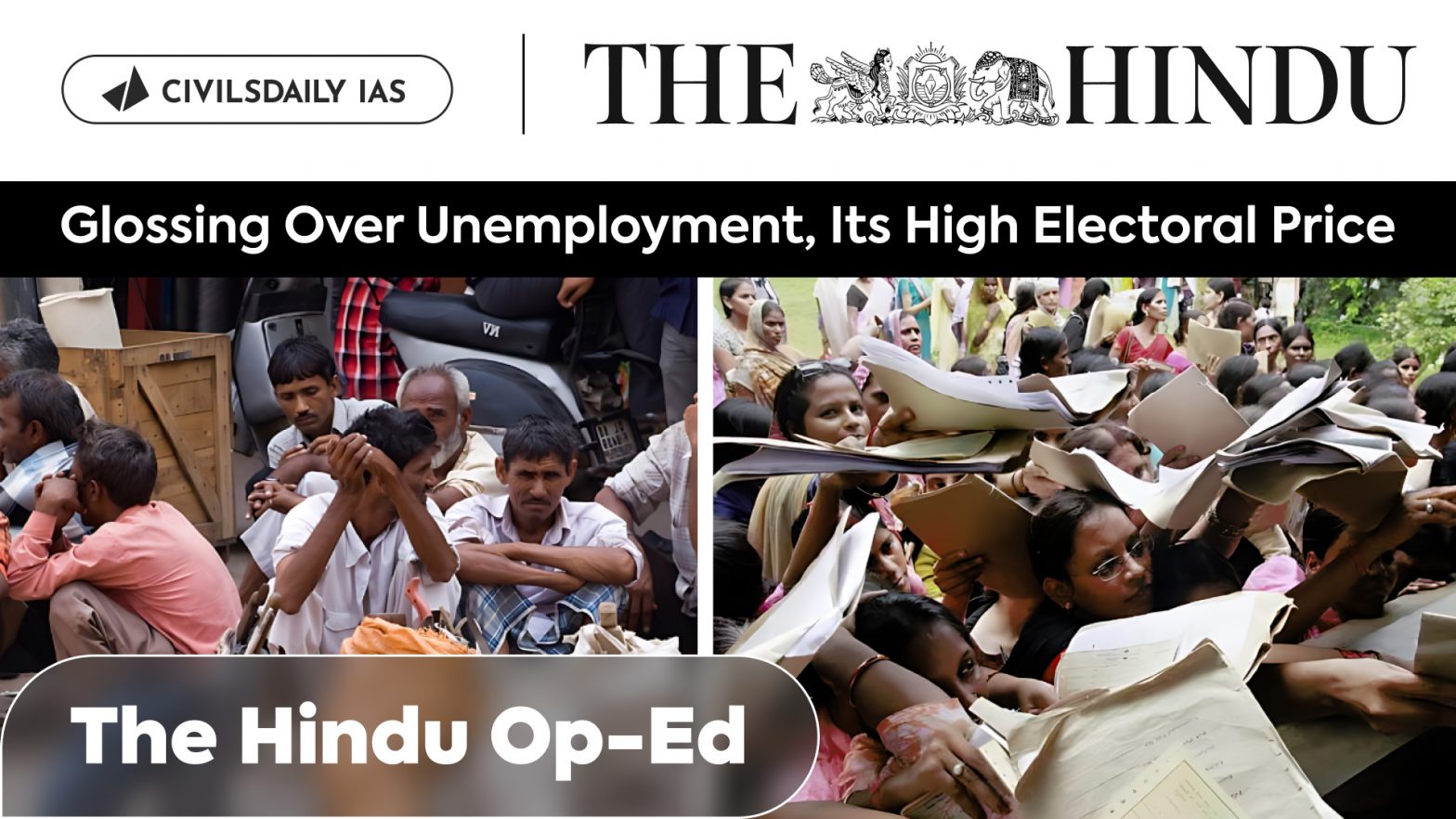| PYQ Relevance: Q Define potential GDP and explain its determinants. What are the factors that have been inhibiting India from realizing its potential GDP? (UPSC IAS/2020) Q Besides the welfare schemes, India needs deft management of inflation and unemployment to serve the poor and the underprivileged sections of society. Discuss. (UPSC IAS/2022) |
Mentor comment: The Indian economy needs to generate over 25 million jobs in the next five years to employ all the currently unemployed. Despite the Narendra Modi government’s claim of an 8% GDP growth rate last year, job creation has not kept pace. Although the unemployment rate for those aged 15 and above decreased from 4.2% in 2021 to 3.1% in 2023, this improvement is insufficient. In the 2024 general election, the Bharatiya Janata Party lost its majority, forming a coalition with parties holding different economic views due to the job market setback.
Let’s Learn!
__
Why in the news?
The Modi government claimed 8% GDP growth last year, but this has not translated into adequate job creation, as shown by current unemployment rates.
Inequality gap is widening
- Rising Wealth Inequality: In the past two decades, the gap between the rich and the poor has significantly widened. Official statistics reveal that 1% of India’s population now owns 40% of the country’s wealth.
- K-shaped Economic Inequality: The term “K-shaped” inequality describes the phenomenon where income and consumption for a few are rising, while for the majority, it is declining.This has been particularly evident over the past decade under BJP central rule.
- Income Inequality: The World Inequality Report 2022 highlights that India is one of the most unequal countries globally, with the top 10% and top 1% of the population earning 57% and 22% of the national income, respectively. Meanwhile, the bottom 50% see their share reduced to 13%.
- Tax Burden on the Poor: About 64% of the total Goods and Services Tax (GST) revenue in India is contributed by the bottom 50% of the population, whereas only 4% comes from the top 10%.
- Healthcare as a Luxury: Many Indians struggle to access necessary healthcare, with 63 million people (nearly two every second) pushed into poverty each year due to healthcare costs.
- Food Security and Nutrition: According to “The State of Food Security and Nutrition in the World, 2023,” around 74% of India’s population cannot afford a healthy diet, and 39% fall short of a nutrient-adequate diet.
- Global Hunger Index 2023: India’s 2023 Global Hunger Index score is 28.7, categorized as “serious” on the GHI Severity of Hunger Scale.
Cause of inequality:
- Structural economic factors: India has struggled to shift its large agricultural workforce towards more productive and better-paying jobs in the formal economy. The economic boom has primarily benefited the top 10-20% while leaving the poor behind.
- Policy shocks disproportionately impacting the informal sector: Demonetization, GST implementation, and COVID-19 lockdowns have severely disrupted livelihoods and employment for India’s large informal economy, exacerbating inequality
- Uneven distribution of wealth and income: The richest 1% of Indians now own over 40% of the country’s wealth, while the bottom 50% possess only 3% of the wealth. This wealth concentration at the top has accelerated in recent decades.
- Lack of effective wealth redistribution: Measures like wealth taxes on the super-rich and greater investment in social welfare, healthcare, and education have been lacking, perpetuating the inequality cycle.
Growth could slip because of
- Heavy Reliance on Government Expenditure: The recent GDP growth has been driven significantly by a large Budget deficit and massive government capital expenditure rather than structural investments in key sectors like industry, agriculture, and services.
- Lack of Structural Investments: Structural investments in the industrial, agricultural, and service sectors are crucial for sustainable economic growth. The absence of significant investments in these sectors means that the foundational aspects of the economy remain weak, potentially hindering long-term growth.
- Historical GDP Growth Decline: The GDP growth rate has shown significant declines in the past, such as falling from 8% to 3.8% in the fourth quarter of 2019-20. This trend indicates a vulnerability in maintaining high growth rates, especially without addressing underlying economic issues.
- Fiscal Deficit Concerns: A significantly large Budget deficit to fund government expenditure can lead to concerns about fiscal sustainability.
- Global Economic Conditions: The global economic environment, including factors such as inflation, interest rates, and geopolitical tensions, can impact India’s growth prospects.Any adverse changes in the global economy could further strain India’s growth trajectory.
- Sectoral Weaknesses: Weaknesses in key sectors such as manufacturing, agriculture, and services can drag down overall economic growth.
Way forward:
- Support for SMEs and Informal Sector: Given that 92% of jobs in agriculture and 73% of jobs in industry and services are in the unorganised sector, policies aimed at supporting small and medium enterprises (SMEs) and the informal sector are crucial.
- Agricultural Reforms and Rural Development: Focusing on modernising agriculture through technology, better irrigation, crop diversification, and improving rural infrastructure can boost productivity and incomes in rural areas.
- Education and Skill Development: Investing in education and skill development is essential to equip the workforce with the necessary skills for the evolving job market.

